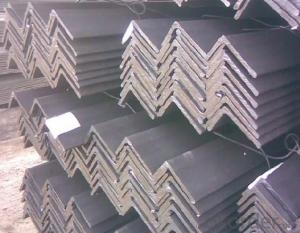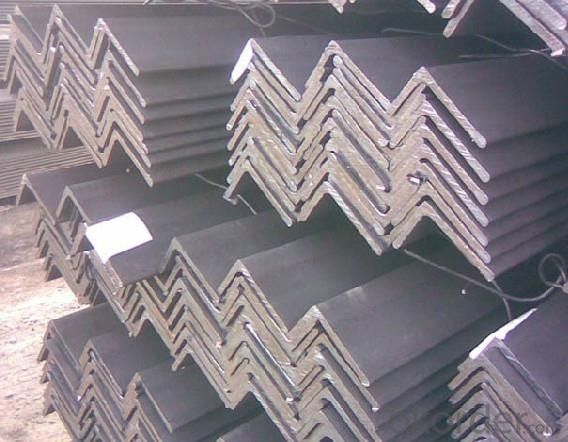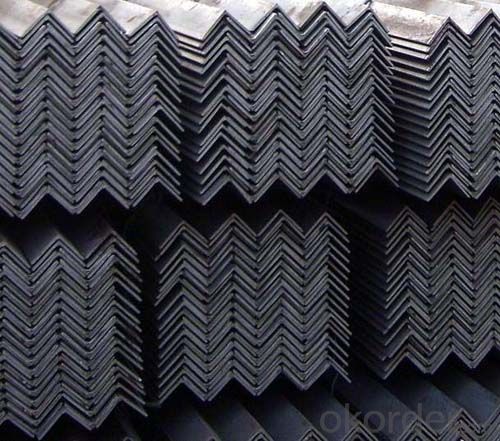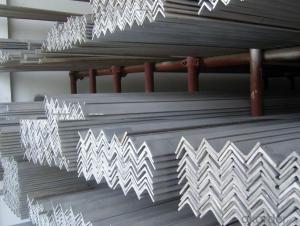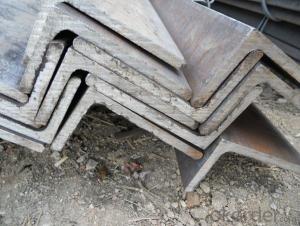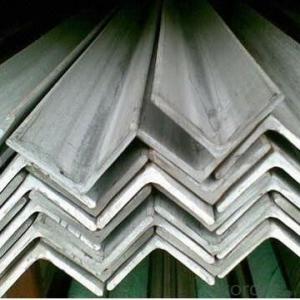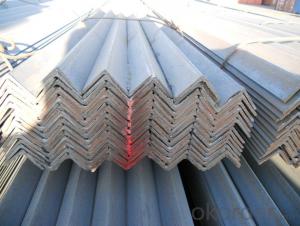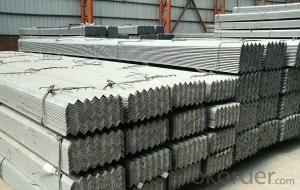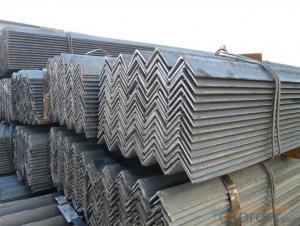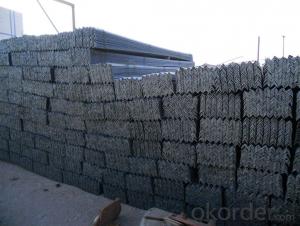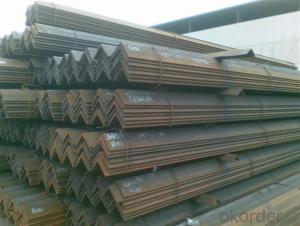GB Q345 Steel Angle with High Quality 75*75mm
- Loading Port:
- Tianjin
- Payment Terms:
- TT or LC
- Min Order Qty:
- 25 m.t
- Supply Capability:
- 10000 m.t/month
OKorder Service Pledge
OKorder Financial Service
You Might Also Like
Specifications of GB Q345 Steel Angle with High Quality 75*75mm:
1.Standards: GB
2.Material: Q345 or Equivalent
3.Length: 6m, 12m
4.Size:
| Size (mm) | Mass (kg/m) | Size (mm) | Mass (kg/m) |
| 75*75*6 | 6.905 | 75*75*8 | 9.030 |
| 75*75*7 | 7.976 |
Usage & Applications of GB Q345 Steel Angle with High Quality 75*75mm:
Trusses;
Transmission towers;
Telecommunication towers;
Bracing for general structures;
Stiffeners in structural use.
Packaging & Delivery of GB Q345 Steel Angle with High Quality 75*75mm:
1. Transportation: the goods are delivered by truck from mill to loading port, the maximum quantity can be loaded is around 40MTs by each truck. If the order quantity cannot reach the full truck loaded, the transportation cost per ton will be little higher than full load.
2. With bundles and load in 20 feet/40 feet container, or by bulk cargo, also we could do as customer's request.
3. Marks:
Color mark: There will be color marking on both end of the bundle for the cargo delivered by bulk vessel. That makes it easily to distinguish at the destination port.
Tag mark: There will be tag mark tied up on the bundles. The information usually including supplier logo and name, product name, made in China, shipping marks and other information request by the customer.
If loading by container the marking is not needed, but we will prepare it as customers' request.
FAQ:
Q1: Why buy Materials & Equipment from OKorder.com?
A1: All products offered byOKorder.com are carefully selected from China's most reliable manufacturing enterprises. Through its ISO certifications, OKorder.com adheres to the highest standards and a commitment to supply chain safety and customer satisfaction.
Q2: How do we guarantee the quality of our products?
A2: We have established an advanced quality management system which conducts strict quality tests at every step, from raw materials to the final product. At the same time, we provide extensive follow-up service assurances as required.
Q3: How soon can we receive the product after purchase?
A3: Within three days of placing an order, we will arrange production. The shipping date is dependent upon the quatity, how many sizes you want and the plan of production, but is typically 30 to 45 days from the beginning of production.
Images of GB Q345 Steel Angle with High Quality 75*75mm:
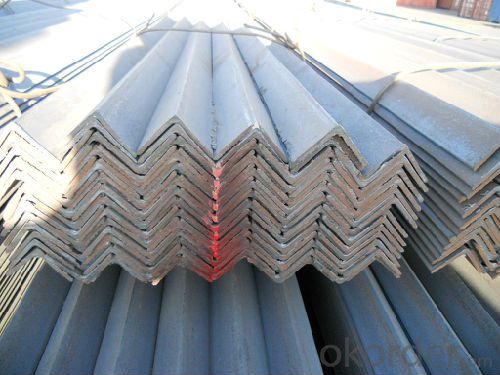
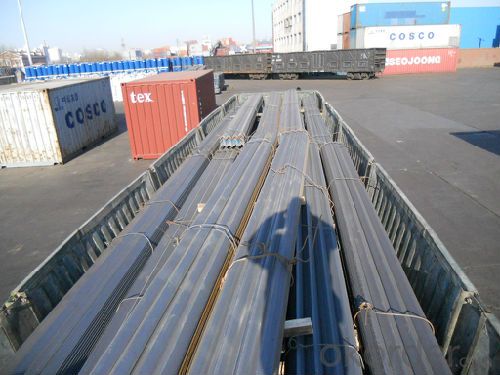
*If you would like to get our price, please inform us the size, standard/material and quantity. Thank you very much for your attention.
- Q: Can steel angles be used in sign support structures?
- Absolutely! Sign support structures can definitely utilize steel angles. These angles are widely employed in construction owing to their remarkable robustness and endurance. They offer exceptional support and stability, rendering them ideal for various applications, including sign support structures. By welding or bolting steel angles together, a strong framework can be effortlessly created for sign mounting. Furthermore, their exceptional load-bearing capacity is crucial in guaranteeing the sign's security and stability, particularly during unfavorable weather conditions. Moreover, steel angles can be tailored to meet specific design specifications, making them a versatile option for sign support structures.
- Q: What are the typical lengths of steel angles?
- The typical lengths of steel angles vary depending on their intended use and application. However, steel angles are commonly available in standard lengths of 20 feet or 6 meters. These standard lengths are often preferred by manufacturers and construction companies due to their convenience and ease of transportation. Additionally, steel angles can be custom cut to specific lengths as per the requirements of a particular project.
- Q: Are steel angles suitable for playground equipment?
- Yes, steel angles are suitable for playground equipment. They provide structural support, stability, and durability, making them ideal for creating safe and long-lasting playground structures.
- Q: What are the considerations for selecting the appropriate steel angle finish?
- When selecting the appropriate steel angle finish, there are several considerations to keep in mind. Firstly, the intended use and environment of the steel angle should be considered. If the angle will be exposed to harsh weather conditions or corrosive substances, a finish with high resistance to corrosion, such as galvanized or stainless steel, would be suitable. Additionally, the aesthetic requirements of the project should be taken into account. Different finishes, such as powder coating or painted finishes, can provide a range of colors and textures to enhance the appearance of the steel angle. Finally, the budget and cost-effectiveness of the finish should be considered, as some finishes may be more expensive than others. Overall, it is important to select a steel angle finish that meets both the functional and aesthetic requirements of the project while being compatible with the intended environment.
- Q: Can steel angles be used as supports for solar panels?
- Yes, steel angles can be used as supports for solar panels. Steel angles provide structural stability and are commonly used in construction for their strength and durability. They can be easily customized and installed to provide a sturdy framework for mounting solar panels, ensuring proper support and optimal positioning for maximum energy production.
- Q: How do you protect steel angles from weathering?
- To protect steel angles from weathering, there are several effective methods that can be employed. The most common approach is to apply a protective coating or paint specifically designed for steel surfaces. This coating acts as a barrier, preventing moisture and oxygen from coming into direct contact with the steel and thus reducing the chances of rust formation. It is essential to choose a coating that is weather-resistant and provides long-term durability. Before applying the protective coating, it is crucial to thoroughly clean the steel angles to remove any dirt, grease, or existing rust. This can be done through abrasive cleaning methods such as sandblasting or using a wire brush. After cleaning, the surface should be primed with a corrosion-resistant primer, which enhances the adhesion of the protective coating. Regular maintenance is also essential to ensure the ongoing protection of steel angles from weathering. This includes inspecting the coating periodically for any signs of damage or wear and promptly addressing any issues that arise. Touching up areas where the coating has been compromised is necessary to maintain the integrity of the protective layer. Moreover, proper design and installation techniques can also contribute to protecting steel angles from weathering. Ensuring that the angles are adequately sealed and protected from direct exposure to rain, snow, or other moisture sources is vital. This can be achieved through proper drainage systems, such as gutters or downspouts, to redirect water away from the steel angles. Lastly, considering alternative materials or coatings that are inherently resistant to weathering, such as stainless steel or galvanized steel, can provide an added layer of protection against environmental elements. These materials have a higher resistance to corrosion and are more suitable for outdoor applications where weathering is a concern. By implementing a combination of protective coatings, regular maintenance, proper design, and utilizing weather-resistant materials, steel angles can be effectively protected from weathering and maintain their structural integrity over an extended period.
- Q: How are steel angles protected against fire damage?
- Steel angles can be protected against fire damage through the application of fire-resistant coatings or by encasing them in fireproof materials such as concrete or gypsum board. Additionally, fireproofing sprays or intumescent paints can also be used to provide a layer of insulation that helps to slow down the spread of fire and protect the steel angles from excessive heat.
- Q: How do you specify steel angles in a construction project?
- When specifying steel angles in a construction project, one must consider their dimensions, grade, and any additional requirements. The dimensions are typically described as the length of each leg and the thickness of the material. For instance, a common specification may be "2-inch by 2-inch by 1/4-inch steel angle". The grade of the steel angle is also crucial to determine its strength and durability. Common grades include A36, A572, and A588. The selection of the grade depends on the project's structural requirements and environmental conditions. Apart from dimensions and grade, any additional requirements like corrosion resistance, fire resistance, or special finishes should be clearly stated. For example, if the steel angles will be exposed to outdoor elements, they might need to be hot-dip galvanized or coated with a protective paint. It is essential to refer to relevant codes and standards, such as the American Institute of Steel Construction (AISC) manual, for guidance on specifying steel angles in a construction project. These codes provide guidelines on allowable stress, design criteria, and other factors to ensure the safe and efficient use of steel angles in structural applications.
- Q: Can steel angles be used for stair stringers?
- Yes, steel angles can be used for stair stringers. Steel angles are commonly used in construction for their strength and durability. When used as stair stringers, steel angles provide the necessary support and stability for the stairs. They can be easily cut and welded to the desired shape and size, making them a versatile option for stair construction. Additionally, steel angles are resistant to rot, termites, and other forms of damage, ensuring the longevity of the stair structure. However, it is important to consult with a structural engineer or a professional contractor to ensure that the steel angles meet the specific requirements and load-bearing capacity for the intended stair design.
- Q: What are the alternatives to steel angles in construction?
- There are several alternatives to steel angles in construction that offer different advantages and disadvantages depending on the specific application. 1. Aluminum angles: Aluminum angles are lightweight and corrosion-resistant, making them a popular choice for outdoor construction projects. They are also easily machinable and have good electrical conductivity. However, aluminum angles may not have the same strength and load-bearing capacity as steel angles, making them less suitable for heavy-duty structural applications. 2. Fiberglass angles: Fiberglass angles are lightweight, non-conductive, and highly resistant to corrosion and chemical damage. They are commonly used in industries where exposure to harsh environments, such as water or chemicals, is a concern. However, fiberglass angles may not have the same strength as steel angles and may require additional reinforcement for heavy loads. 3. Carbon fiber angles: Carbon fiber angles are lightweight, high-strength, and have excellent resistance to corrosion. They are commonly used in applications where weight reduction is critical, such as aerospace and automotive industries. However, carbon fiber angles tend to be more expensive than steel angles and may require specialized manufacturing techniques. 4. Wood angles: Wood angles, typically made from hardwood or engineered wood products, are a traditional alternative to steel angles in construction. They are readily available, cost-effective, and easy to work with. Wood angles are often used in residential and light commercial construction projects. However, wood angles may not have the same strength and durability as steel angles and may be more prone to warping, cracking, or rotting over time. It's important to consider the specific requirements of the construction project, including the load-bearing capacity, environmental conditions, and budget, when choosing an alternative to steel angles. Consulting with a structural engineer or construction professional can help determine the most suitable option for each specific scenario.
Send your message to us
GB Q345 Steel Angle with High Quality 75*75mm
- Loading Port:
- Tianjin
- Payment Terms:
- TT or LC
- Min Order Qty:
- 25 m.t
- Supply Capability:
- 10000 m.t/month
OKorder Service Pledge
OKorder Financial Service
Similar products
Hot products
Hot Searches
Related keywords
